What are LSI keywords? They are words that are semantically related to your main keyword. Search engine algorithms use them to understand context.
LSI keywords can improve your SEO by helping search engines to understand what your content is about. They also help your page rank for related keywords.
- What Are LSI Keywords?
- What Is Latent Semantic Indexing?
- Are LSI Keywords Synonyms?
- Why Do Search Engines Use LSI Keywords?
- LSI Keywords and Searcher Intent
- Using Semantically Related Keywords
- Where To Use LSI Keywords
- Use Google To Find LSI Keywords
- Tools for Finding LSI Keywords
- How To Add LSI Keywords to Your Blog Post
- LSI Checklist for Optimizing Blog Posts
- Conclusion
- Related Resources
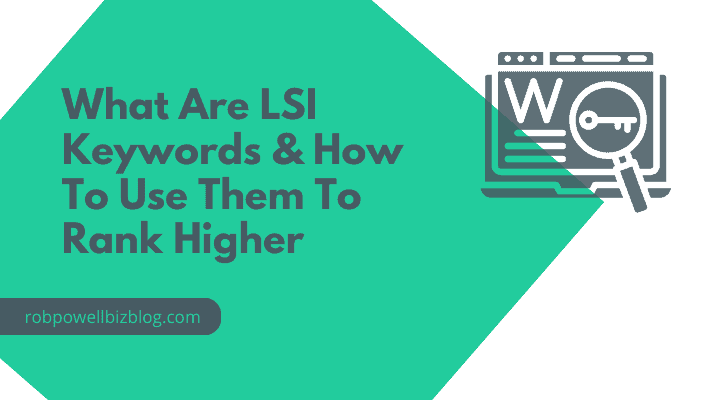
What Are LSI Keywords?
LSI keywords are words that are often found together with your main keyword. In short, they are words that share the same context.
Using complex mathematical models, search engine algorithms detect that groups of words are typically found together in certain contexts. Those patterns are used by search engine algorithms to understand the relevance of a document to a search query.
And that’s why LSI keywords are important in SEO.
What Is Latent Semantic Indexing?
Latent semantic indexing (LSI) is a mathematical technique that detects the way words cluster together in predictable patterns. Search engines use these patterns to understand context.
An example of how latent semantic indexing works is where the same word has two or more different meanings.
For example, the word ‘apple’ could refer to the fruit or the computer.
An algorithm would be able to distinguish between these two uses of the word ‘apple’ by looking at the words found together with the word ‘apple’.
When the word ‘apple’ is found with words like ‘iTunes’, ‘iOS’, and ‘Mac’, an algorithm would know that this is ‘apple’ as in computers.
But where the word ‘apple’ clusters together with words like ‘pear’, ‘orange’, and ‘green’, the same algorithm would know that this is ‘apple’ in the sense of fruit.
Here’s an example of latent semantic indexing in action.
If you type ‘best dates’ into Google, you’ll see a mixture of results:
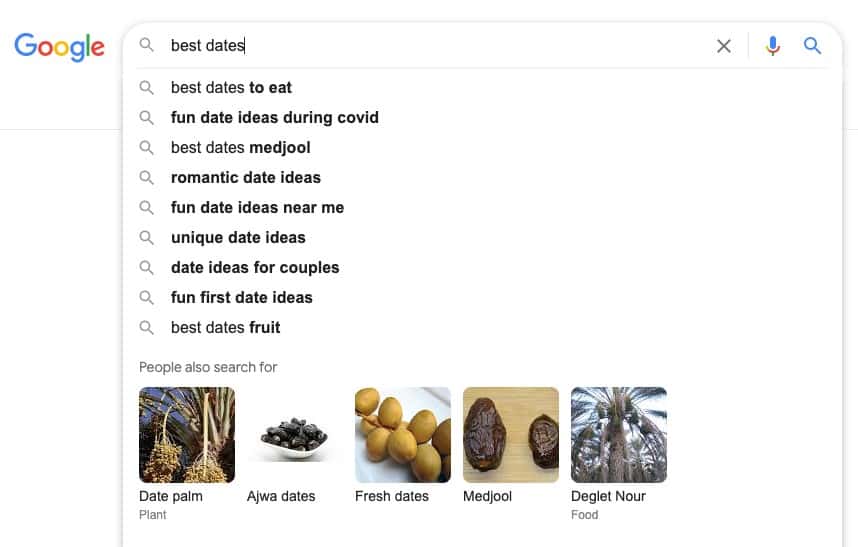
Some of the suggestions relate to ‘dates’ the fruit and some relate to ‘romantic’ dates. That’s because ‘best dates’ doesn’t give the algorithm enough information.
But if you type in ‘best tasting dates’, the suggestions all relate to dates the fruit:
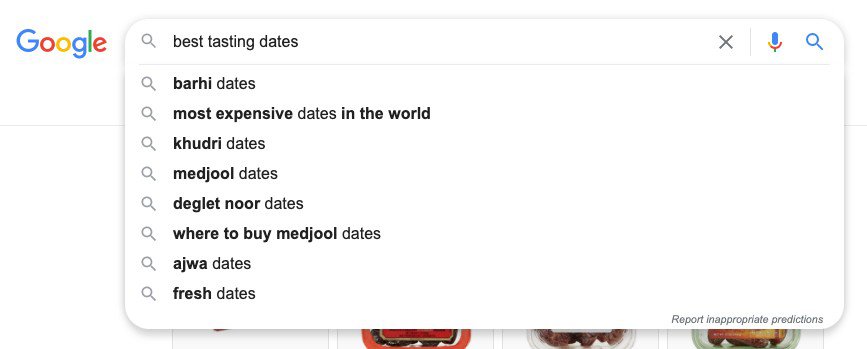
That’s because the algorithm knows that when the word ‘dates’ is found with the word ‘tasting’, it refers to ‘dates’ the fruit.
But if you type in the words ‘most memorable dates’, the suggestions all relate to ‘romantic dates’:
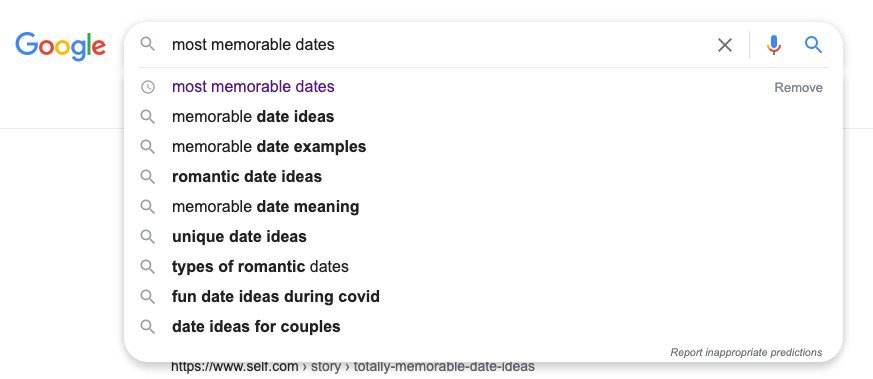
That’s because the algorithm knows that when the word ‘dates’ is found with the word ‘memorable’, it refers to the activity of ‘dating’.
So latent semantic indexing looks at the context in which words are used to understand what those words mean.
Are LSI Keywords Synonyms?
It’s often said that LSI keywords are synonyms.
But this is not entirely accurate.
Rather, LSI keywords are words that share the same context. They are words that are often found together with your main keyword.
For example ‘apple’ and ‘iTunes’ are semantically related keywords, but they are not synonyms. Likewise, ‘dates’ and ‘tasting’ are not synonyms, but they are semantically related words.
Why Do Search Engines Use LSI Keywords?
Back in 1998, the only measure Google had for relevancy of a page to a given search term was keyword density.
But keyword density was easily manipulated through the practice of keyword stuffing.
So Google moved away from keyword density and began looking at LSI keywords.
The reasoning was this:
A legitimate page about ‘Apple computers’ will likely contain a lot of other words and phrases that are related to Apple computers (such as ‘apple stores’, ‘apple iphone 5’, ‘apple new ipad’, ‘apple stock price’, ‘discount computers’).
On the other hand, a keyword-stuffed page about ‘Apple computers’ will probably just contain that one keyword, repeated over and again.
So latent semantic keywords provide Google with a way to differentiate between content that deals with a topic in depth, and content that has been optimized for the search engines by keyword stuffing.
LSI Keywords and Searcher Intent
But there’s another reason search engines started using semantically related keywords.
Latent semantic indexing helps search engines better understand the meaning of a search term.
And that allows search engines to improve the match between what people search for and the content they find in the search results.
Using Semantically Related Keywords
Here are three ways you can use latent semantic keywords to improve your SEO:
Total Context vs. Keyword Density
Google now looks at total context rather than keyword density. LSI words will give more context to your article. This means your page will rank higher for your focus keyword because Google better understands the context of your page.
You reached your limit for keyword density
Let’s say you want to add more keywords in your content but you’ve reached the limit for recommended keyword density – anymore repetitions of your keyword and you risk a Google penalty.
With latent semantic keywords, you can safely keep adding closely related keywords.
Get found for keyword variations
Semantically related keywords are closely related to your focus keyword – they’re ‘keyword variations’.
That means your page is going to come up in the search results for related searches. In other words: more chances of your content being found by people searching on that broad topic.
Where To Use LSI Keywords
Here are some of the places you should use LSI keywords in your article:
- Headings (H2, H3, H4)
- First 100 words
- Image alt text
- Image file names
- Meta description
- Article title
- SERP title
- Conclusion
- Anchor text
Use Google To Find LSI Keywords
The best place to find latent semantic keywords is in Google itself. Here are three places in Google Search where you can look for LSI keywords:
Google Search
Just type in your main keyword into Google and look for LSI keywords in the SERP snippets.
Let’s say you’re writing an article about ‘tendonitis’. Here are some LSI words for ‘tendonitis’ that you can see in the SERP snippets:
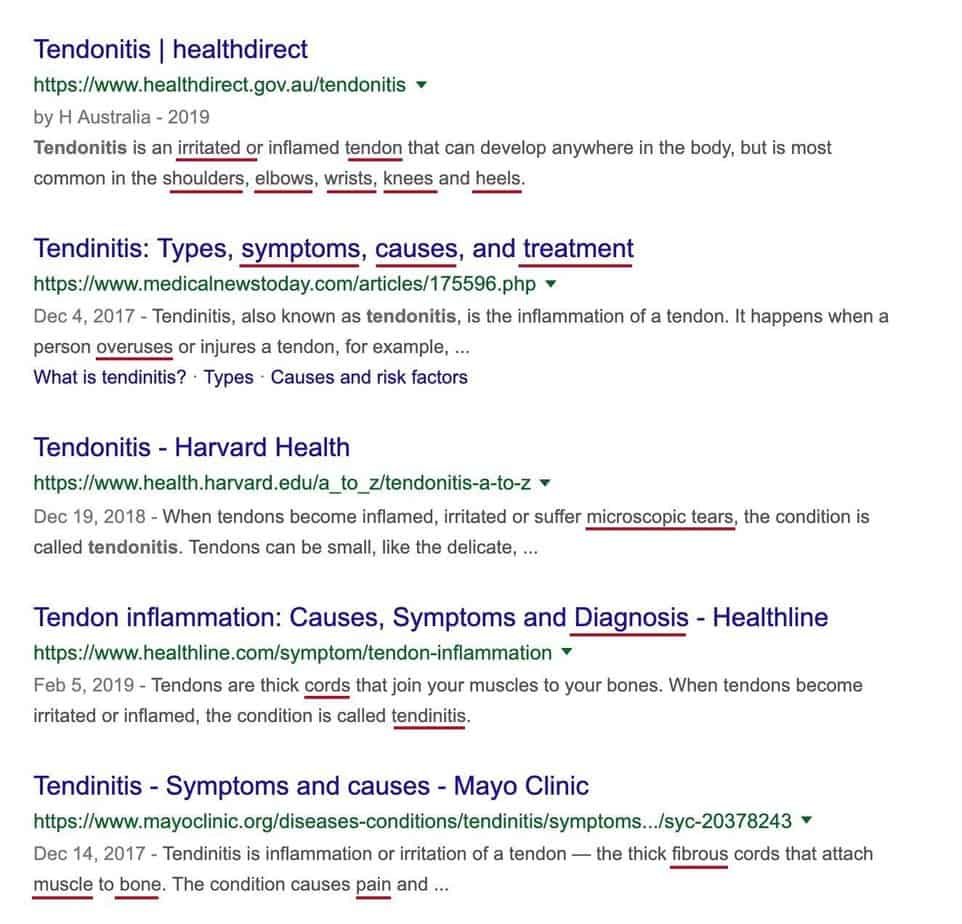
These 19 words I found in the SERP snippets for ‘tendonitis’ are all LSI keywords because they share the same context as the ‘tendonitis’:
- irritated
- tendon
- shoulders
- symptoms
- causes
- treatment
- elbows
- wrists
- knees
- heels
- overuses
- microscopic tears
- diagnosis
- cords
- tendinitis
- fibrous
- muscle
- bone
- pain
Google Auto Suggest
As soon as you start typing a search term into Google, Google Auto Suggest comes up with related words and phrases that people also search for.These also contain semantically related keywords and they’re great for search engine optimization. Add them as keywords in your content and you will increase the topical relevance of your article or blog post.
Here are the Google Auto Suggest terms for ‘tendonitis’:
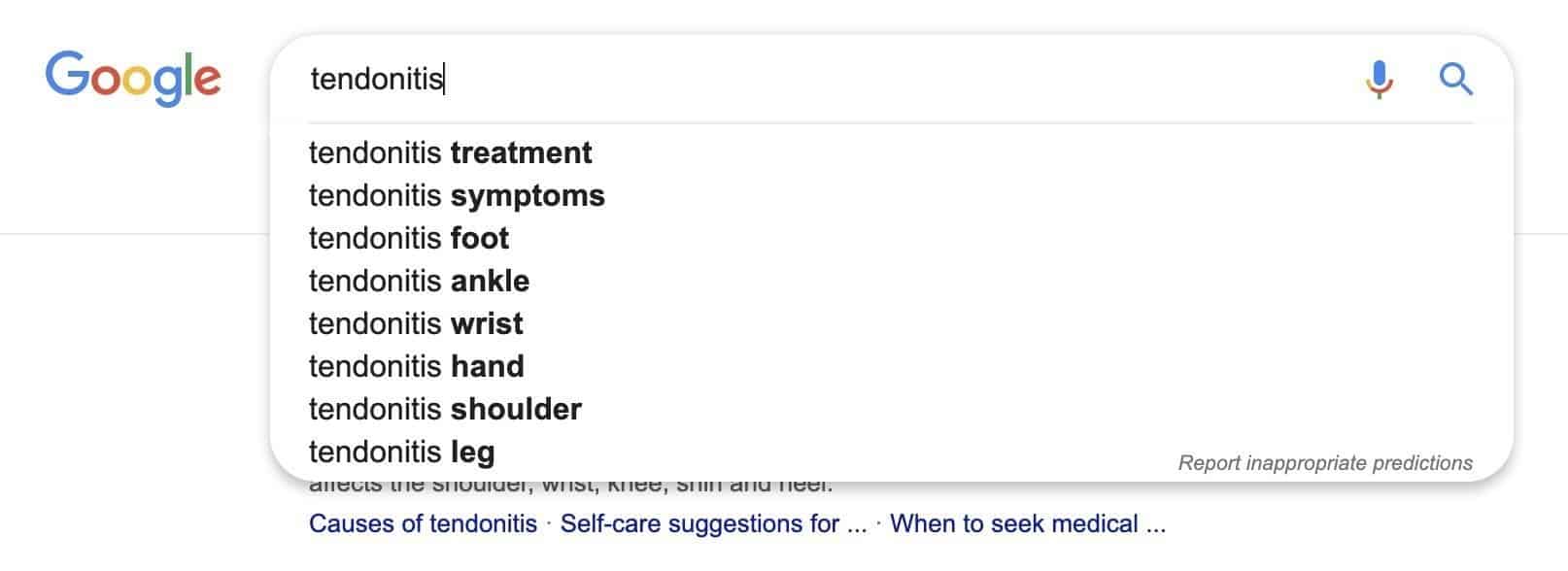
In this instance, I already have these words from the previous exercise. But what if I click on ‘tendonitis wrist’:

That gives me some additional LSI words. You can keep drilling down through the Auto Suggest entries and find more and more latent semantic keywords.
Google’s ‘Searches Related To’
A third way to find latent semantic indexing words in Google Search is to look at ‘Searches Related To’ at the foot of the SERPs page:
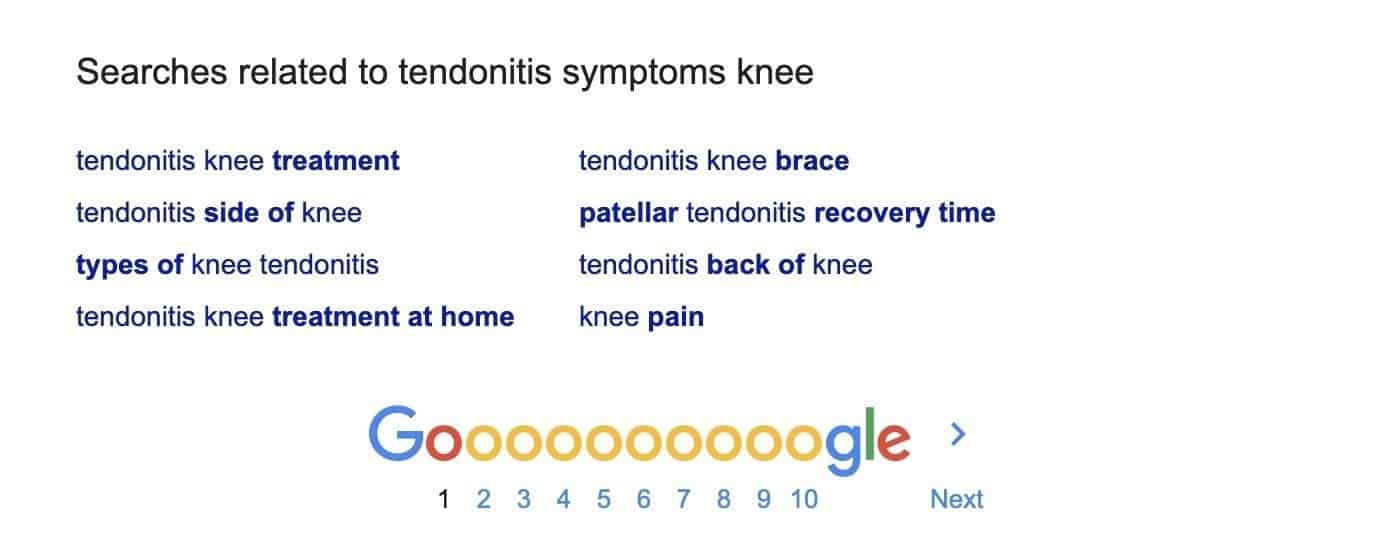
Tools for Finding LSI Keywords
There are also a number of keyword research tools dedicated to finding semantically related keywords.
LSI Graph
LSIGraph is a free tool for generating LSI keywords.
Just enter your main keyword:
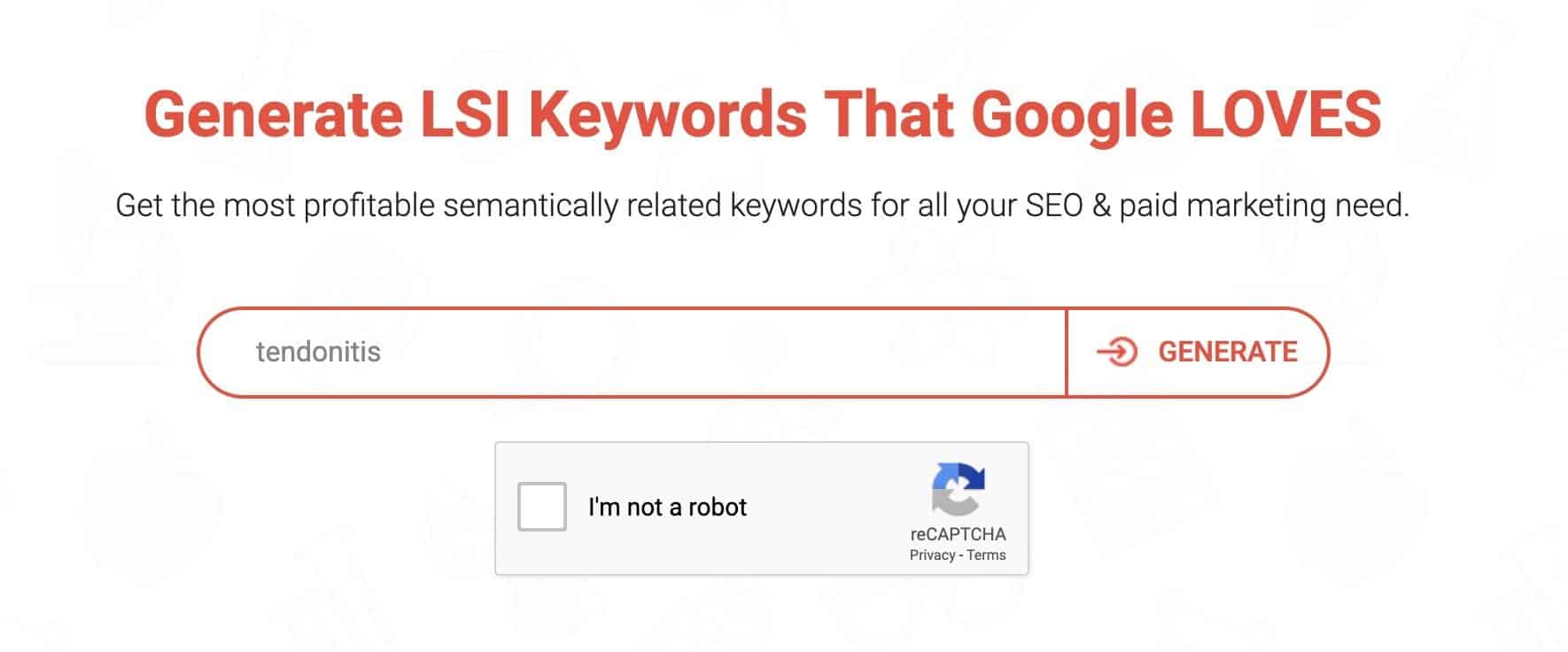
Then scroll through the results for more LSI keywords:
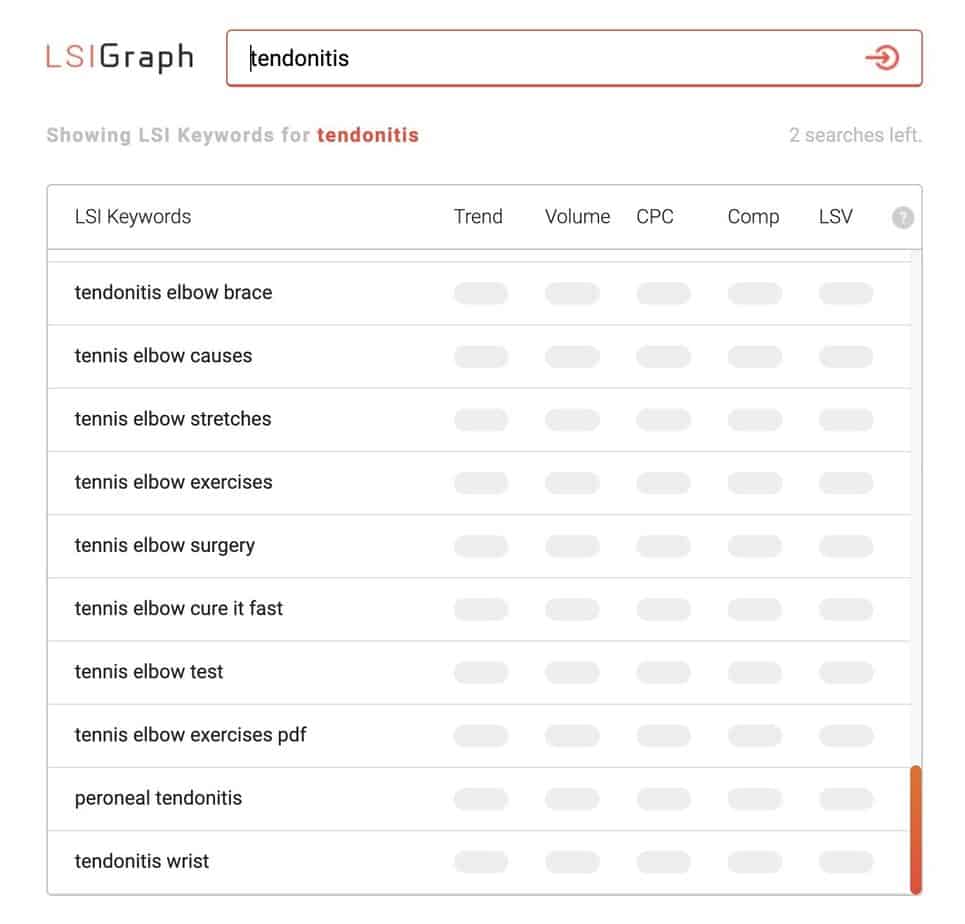
LSI Keywords
As with the previous tool, just enter your seed word and hit ‘search’. This tool returns a massive list of over 1,800 keywords related to ‘tendonitis”:
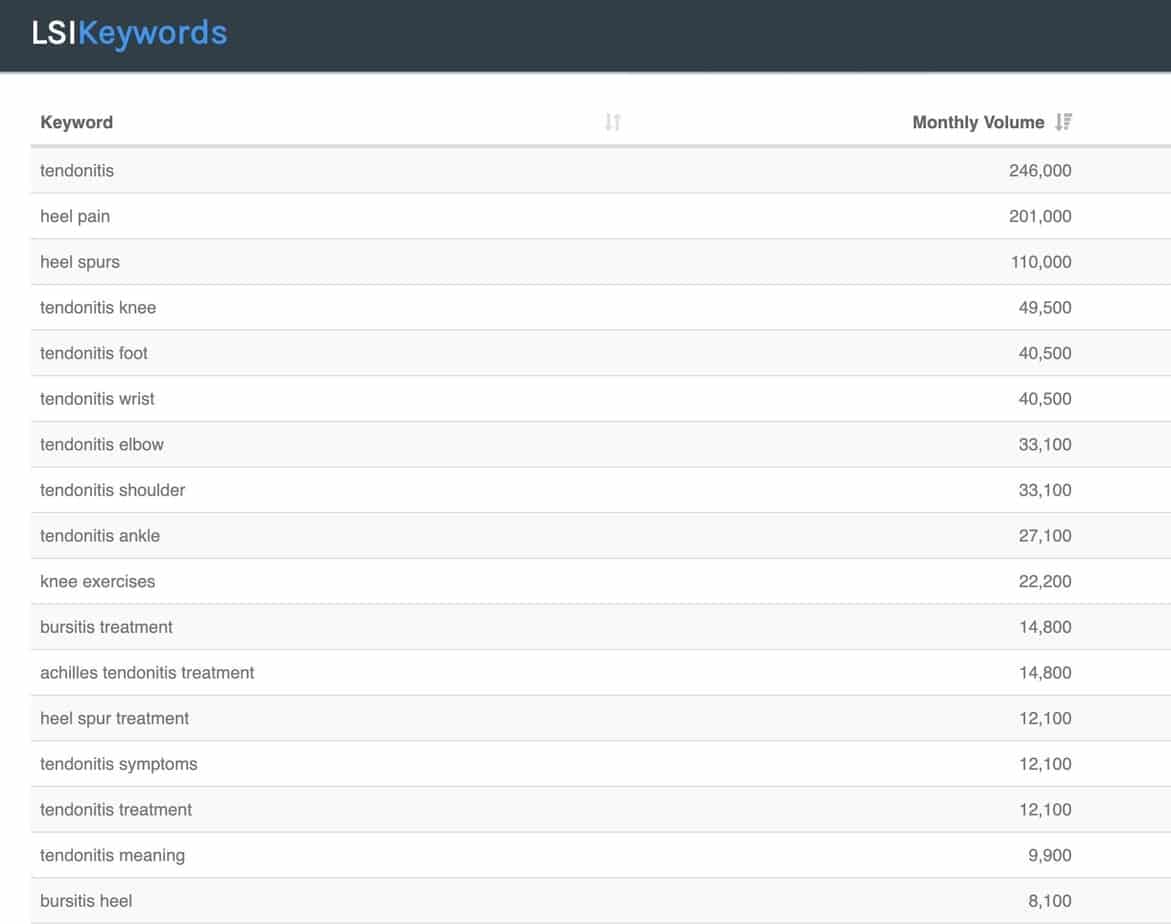
Ubersuggest
This is another great tool for finding latent semantic indexing words. In my case, it gives me over 300 of them:
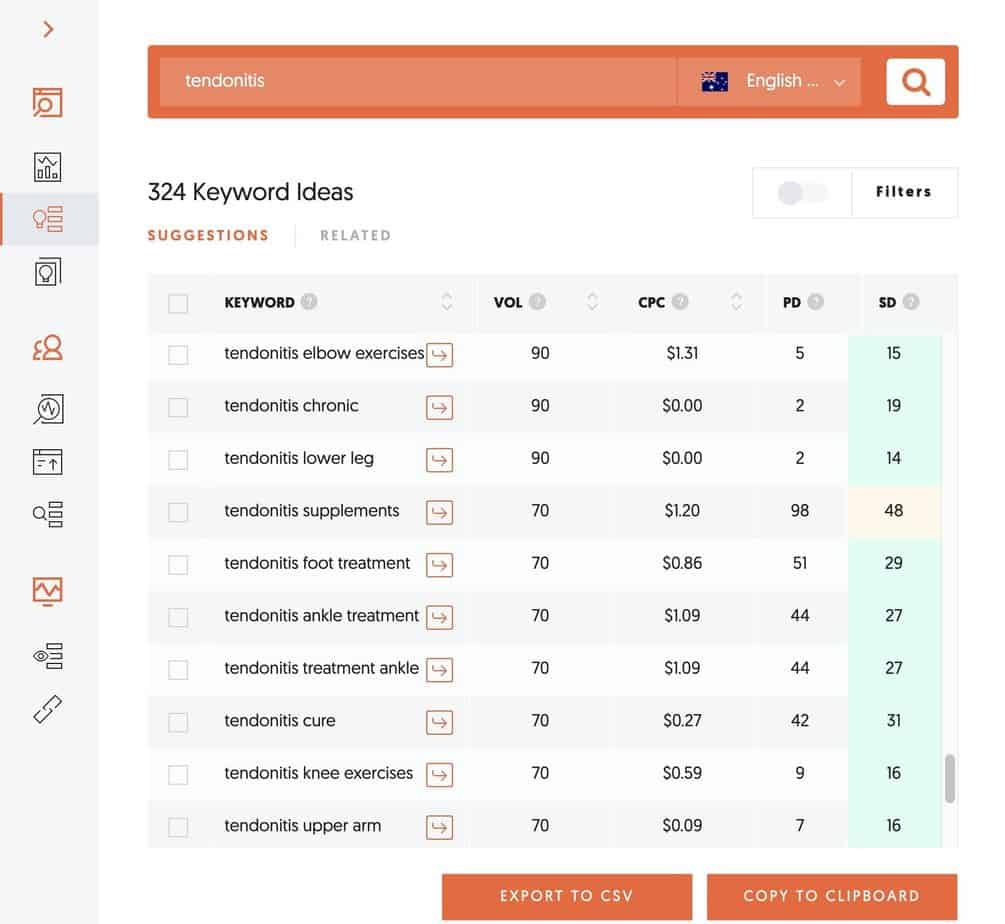
How To Add LSI Keywords to Your Blog Post
Adding latent semantic indexing words to your article isn’t always easy, especially if you have to re-write parts of your article to fit the new words in.
But here are two super-easy ways to add LSI words to your blog post without having to re-write anything:
Add a ‘Further Reading’ panel
Under each section of your article, add a ‘Further Reading‘ panel that lists three to five articles related to the topic of that section.
These articles will inevitably contain LSI keywords in their titles. And those words will improve the topical authority of your article.
Let’s say you have an article on ‘Cures for Tendonitis’. You could add a ‘Further Reading’ panel at the end of that section, like this:

With that single ‘Further Reading’ panel, I’ve just added 10 LSI keywords to my page.
Add a ‘Related Articles’ Panel
If you’ve written other articles on the same general topic, you can link to them in a ‘Related Articles‘ panel. The titles of these articles will almost certainly contain latent semantic indexing words.
Here’s an example:
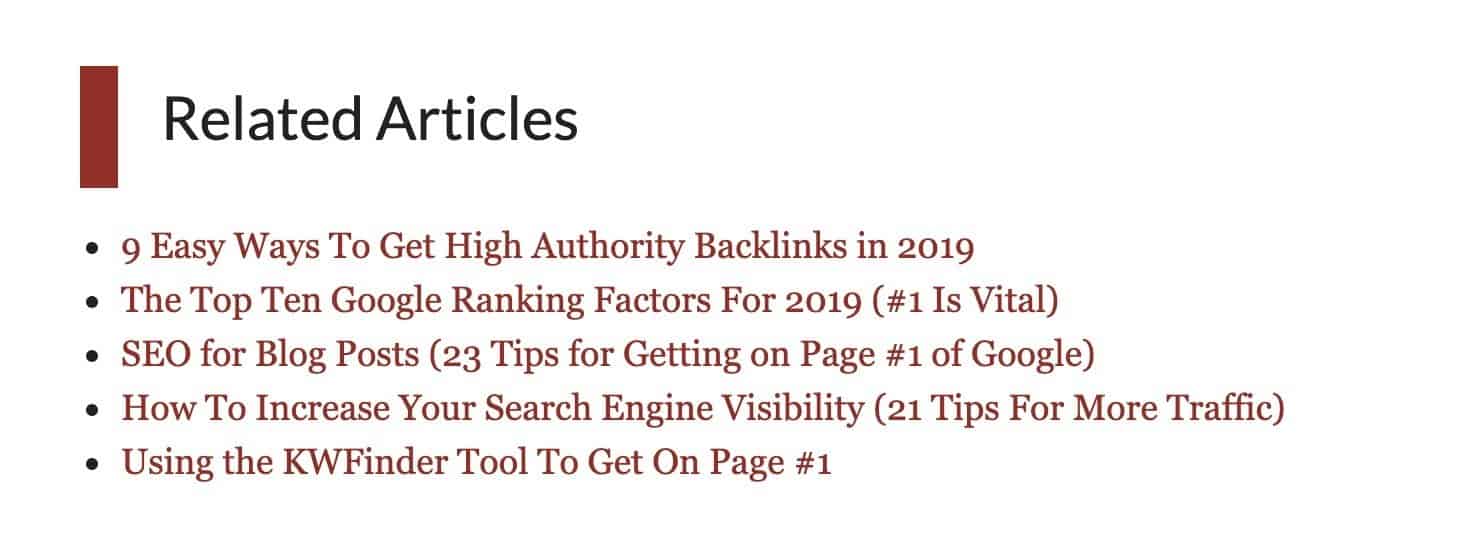
The main article targets the keyword ‘domain authority’. This ‘Related Articles’ panel contains five keywords related to ‘domain authority’.
LSI Checklist for Optimizing Blog Posts
Here’s a checklist to help you quickly optimize any blog post for semantically related keywords:
Google Search Results
Look for bolded words in the Google search results: these are LSI keywords that you can add to your content to increase your topical authority.
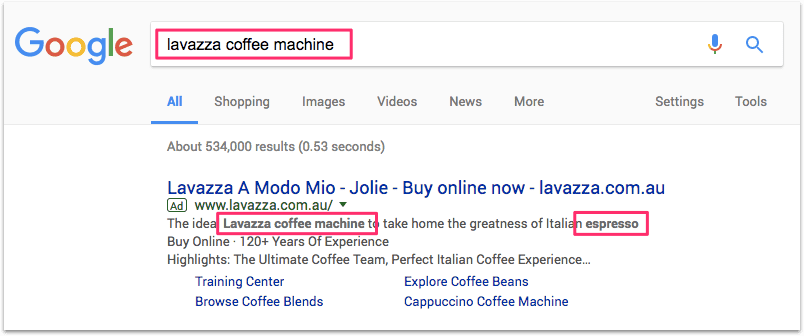
Google Auto Suggest
Scan the keywords that appear in Google’s Auto Suggest feature. These are also LSI keywords:
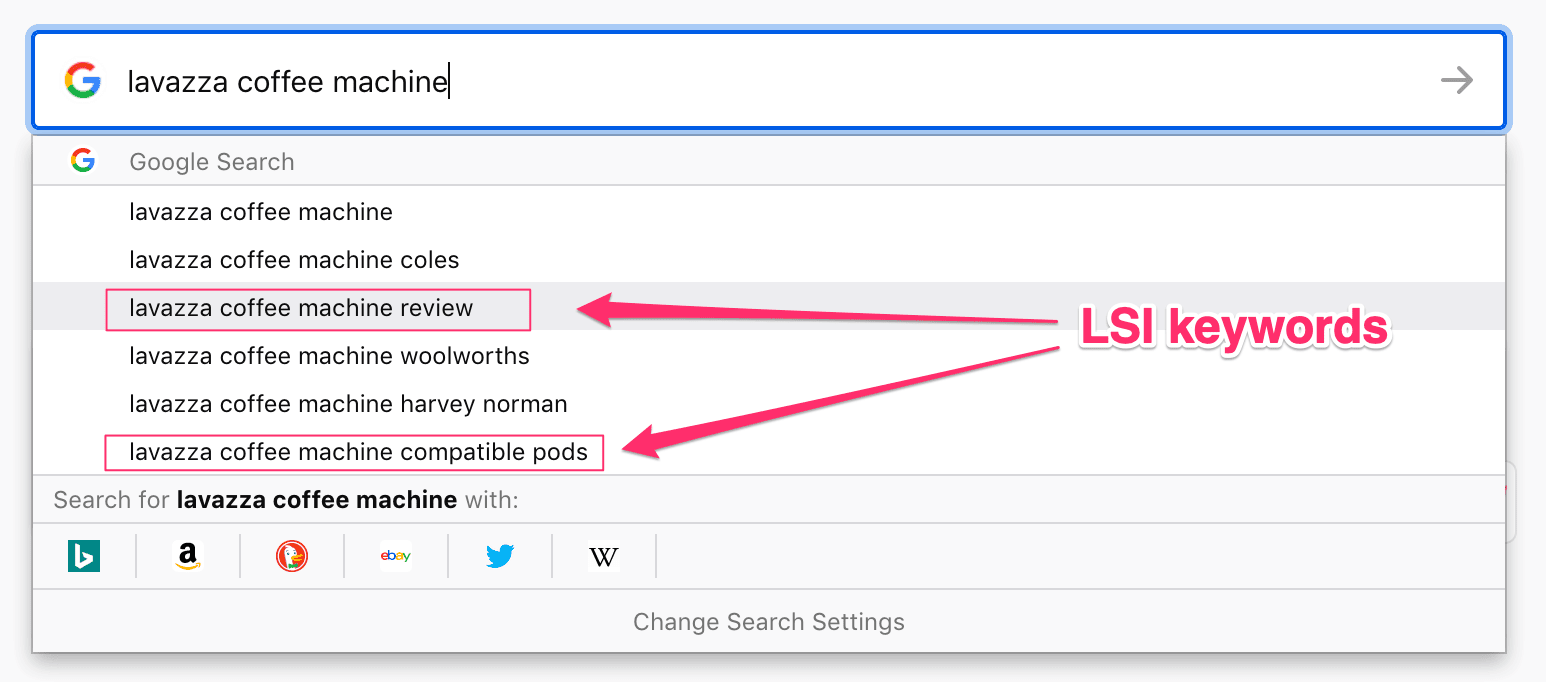
Google’s ‘Searches Related To’
Scroll down to the foot of the Google search results and look at Google’s ‘Searches Related To’. These are LSI keywords that you can use to expand your article or blog post:
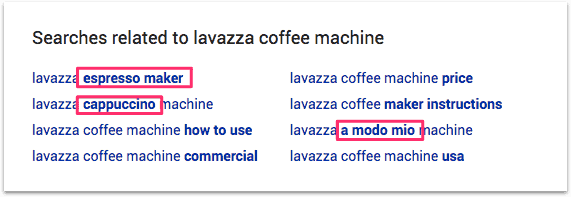
Include LSI keywords in your SEO Title
Your main keyword should be at the beginning of your SEO title, but you can also include an LSI keyword in your title:
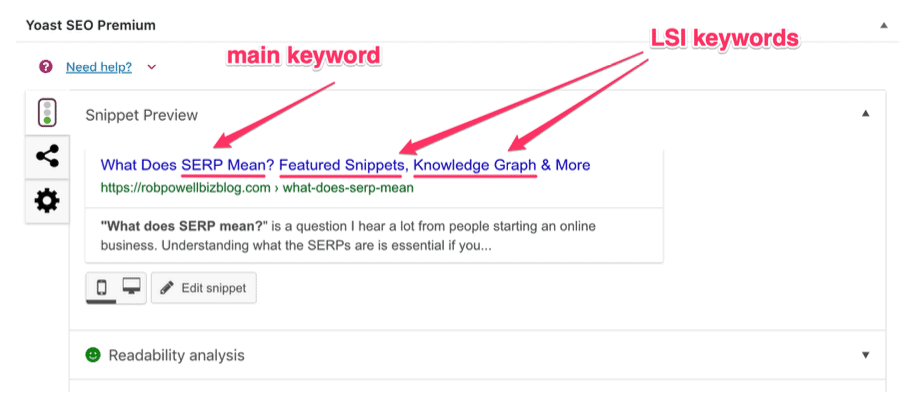
Description Tag
Use your primary keyword and LSI keywords in the description tag of your SERP snippet:
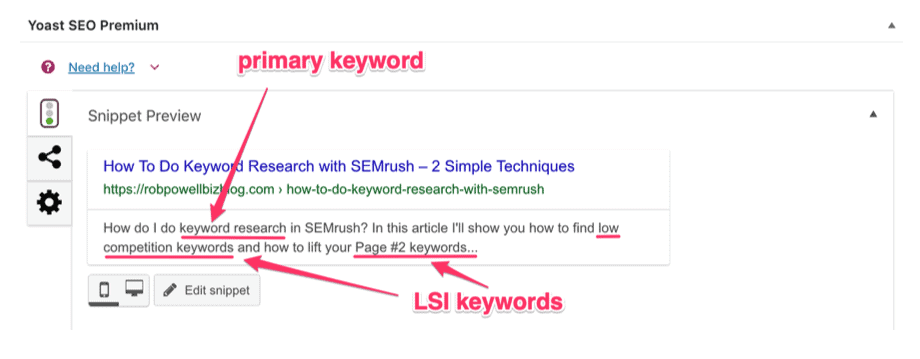
Headings and Subheadings
Include LSI Keywords in your headings and subheadings:
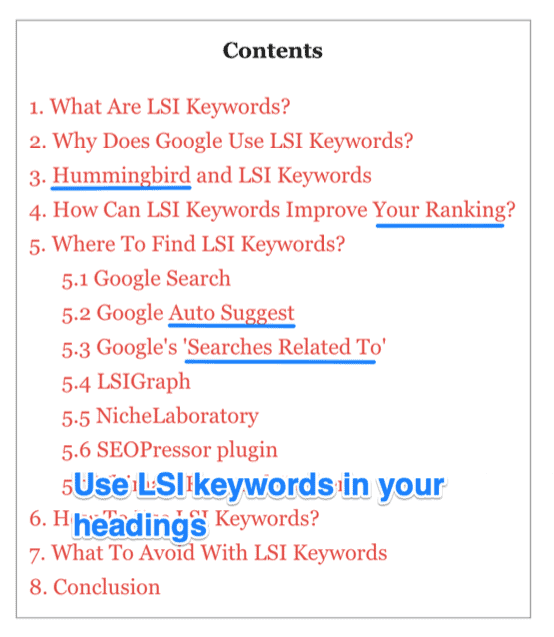
Conclusion
Latent semantic keywords are a vital part of how search engines understand and rank content. That’s why it’s important to be aware of them as you optimize your blog posts for SEO.
By finding semantically related keywords, you’ll get a better grasp of the scope of your topic. You’ll also be able to add sub-topics to your content and that will increase the topical authority of your articles and help them to rank higher in the search results.
Not only that, but adding LSI keywords to your content will allow your content to be found in related searches and that will further increase your traffic.
Hey, a few days ago I saw a WordPress plugin created by SEMRush, it is called SEO writing assistant. When you put your focus keyword in it, it will suggest you LSI keywords in real time.
Hope this helps. 🙂
Hi Subhrangshu, it sounds interesting, I’ll check it out. Thanks, Rob 🙂
It’s really a nice article for Beginners. Thanks for publishing this Rob Powell, It’s really helpful.
Hey Aryatk, you’re most welcome, glad you found it useful. Best, Rob.
very useful! thank you very much for your sharing
Thanks Navaruj! Glad it was useful. All the best, Rob.
Fantastic article on LSI keywords. I’m going to bookmark this page and come back to read all over again.
Thx for your article Rob, it will help me to build natural AND relevant content, both for company’s website and related blogs!
I was confused regarding LSI keywords, but now I clear about LSI keywords.
Thank you so much publish a such a great article.
Hi Francois, thanks for your comment, I’m really glad it was helpful. All the best with your new content! – Rob.
Hi Ravi, thanks for your comment. I’m so glad the article was helpful. All the best! – Rob.
Hi Shola, thanks for your feedback – it’s great to get a comment like that! All the best, Rob.
Thanks for clearing my confusions regarding LSI Keywords.
Hi Rohit, you’re most welcome – I’m glad it was useful, Rob.
I was one of those who thought LSI keywords are synonyms of a keyword. But this post changed my perception. Thanks Rob for the great article.
Hi Harish,
Thanks for your comment. Yes, a lot of people think they are synonyms.
I’m glad it was useful.
Best,
Rob.
Hi,
Thanks for your great content! Hope you can teach me a little bit more because I am totally a newbie SEO.
The following are the questions I would like to know more:
What are the LSI keywords in this article?
Is “LSI keywords” itself a main keyword in this article? Is there any other main keywords used in this article?
How many words do you suggest for each blog post which is good for SEO?
Please forgive me and feel free to ignore if you find any of these questions uncomfortable.
Thank you very much in advance!
Hi Sam,
Thanks for your questions.
The LSI keywords I used in the article are:
Latent Semantic Indexing
synonyms
same context
relevancy
keyword density
Hummingbird
semantic algorithm
context of a web page
searcher intent
search query
understand meaning
match user intent
keyword variations
Google Auto Suggest
words that cluster together
search term
Google’s Searches Related To
LSIGraph
NicheLaboratory
semantic indexing
However, I should emphasize that these LSI words just emerged naturally from my discussion of the topic (i.e. I didn’t make a list of relevant LSI words and then insert them). The beauty of LSI words and Latent Semantic Indexing is that when a piece of content covers a topic well, it will naturally contain LSI keywords.
As far as length goes, I would recommend at least 2000 words. Brian Dean of Backlinko analysed 1 Million Google search results and found that the average Google first page result contains 1,890 words. For more on this, please see my article SEO for Blog Posts – 21 Tips for Getting on Page #1 of Google
Hope this helps 🙂
Rob.
Thank you very much for your response!
I’ve also read your advised article. And then many questions come to my mind LOL.
So for LSI keywords, it means that we are not necessary to do LSI keyword research because if our article will naturally contain wordings that related to the topic and those related wordings will be the LSI keywords and become the context of the topic. Instead of searching for LSI keywords, what we should do is to learn deeper about the topic, so that we can write a much all-rounded and contextual article spontaneously. Am I right?
What we should search for is a suitable long-tailed keyword as our main keyword before writing. Then put this long-tailed keyword to suitable places.
Take your articles as examples, I found that “SEO for Blog Posts” 10 times in that article, and “what are lsi keywords” 6 times in this article, including comments.
So with a suitable amount of long-tailed keyword (or the main keyword) inserting to the article in good places, that’s good enough for the keywords. Am I right?
Thank you Thank you!
Hi Sam,
Thanks for your follow-up question.
Yes, that’s absolutely right. If you research all the topics and sub-topics associated with your main keyword and write detailed sections on each of those topics and sub-topics (as described in this article: How To Find Seed Keywords In Your Niche & Increase Topical Authority), then you wouldn’t need to strategically insert LSI keywords throughout your article – those LSI keywords will already be in your article, through a natural process.
The Google algorithm is getting very good at detecting natural vs. unnatural use of keywords. So it’s always better to let your keyword and LSI word density and distribution emerge naturally from your research and writing.
Hope this helps,
Rob.
Thanks for this elaborative post on LSI keywords. Great insights. Will be helpful.
Thanks, Sanjay, I’m glad it was helpful, Rob.
Your content is not fully clear to me. Please clear what is LSI keywords. After reading the post I am still now in confusion.
Hi Zahir,
Thanks for your question.
In a nutshell, LSI keywords are words that cluster together, in association with your main keyword, in predictable patterns.
Because they cluster together in predictable patterns, search engines are able to use them to understand context and meaning.
Hope this helps,
Rob.
Thanks for your reply. Now I have realised the topic.
Hi Ali,
Thanks for your question.
From what I understand, the Google algorithm is capable of conducting semantic indexing in any language. However, the quality of search results by Google in other languages is often lower than in English. But the reason for this is not to do with the capabilities of the algorithm. Rather, it’s because there is less content in those languages and that means that the Google algorithm has had fewer opportunities to conduct deep learning in that language.
Hope this answers your question,
Rob.
Hi Rakesh,
Thanks for your question.
The best thing to do would be to make a list of the holiday destinations that the website will be promoting. Then type each of those holiday destinations into Google. Have a close look at the alternative topics that come up in ‘Google Suggest’. Also, have a close look at the ‘Searches Related To’ information at the foot of the Google Search Results. These will both be excellent places to find related keywords and LSI words. After you’ve done that, click on the results and look at the web pages that Google returned for those holiday destination terms. Scroll down through the content of the top 5 pages and make a list of words that are related to that topic.
You could try using free LSI keyword tools, but I prefer the above method because when you take the LSI words off the Page #1 search results, you *know* that Google has indexed those words as being semantically related to your main keyword.
Here’s a list of free LSI keyword tools: https://www.twinword.com/blog/lsi-tools/.
Hope this helps 🙂
Rob.
Hi Medelin,
Thanks for your question, and thanks for pointing out the confusion.
Some LSI words are synonyms, but not all LSI words are synonyms.
I’ve just edited the text of the article to make this point clearer:
Thanks again for pointing this out.
I hope this clarifies the issue for you.
Best,
Rob
Hi, thanks for your question.
The Hummingbird algorithm, which was announced in September 2013, was the first Google algorithm that was able to understand context and meaning. Before Hummingbird, the Google algorithm focused on individual keywords. But with Hummingbird, Google identifies groups of words that cluster together in predictable patterns. This allows Google to understand context and therefore to understand meaning. This is why Hummingbird is sometimes referred to as the ‘semantic’ algorithm.
For more information about the Hummingbird algorithm and what it does, see my article: What Is RankBrain (& How It Affects Your Ranking In the Search Results)
Hope this answers your question,
Rob.
Hi Rob,
Ashwani Verma this side,
This blog post about seo is one of the most detailed and best i have seen so far and wanna say a very very thankyou for sharing such kind of amazing knowledge .
but one thing i am not able to do is building high quality backlink even after seeing a lot of videos on youtube .
if you could please help me out of this and teach me how to do this , that will be very helpfull for me.
Hi Ashwani,
Thanks for your question.
Building high-quality backlinks is difficult and very time-consuming.
There are many different link-building strategies. The one I’ve had the most success with is HARO (Help A Reporter Out). Here’s an article that explains how to use HARO: https://electriceye.io/blogs/articles/how-to-use-haro-for-backlinks
Hope this helps 🙂
Rob.
Hi, greetings from Indonesia Rob! I really enjoy & love this article! Your explanation about LSI Keywords so clear & deep, So confused about the latest Google Algorithm Updates, Still LSI work fine now? Specially to settle in 1st page Articles. Please answer this question. Thanks before & sorry for my bad english. Terimakasih. 🙂
Hi Praset,
Thanks for the feedback. Yes, LSI keywords are not affected by the Jan 2020 Core Update – they will still help you get on Page #1.
– Rob